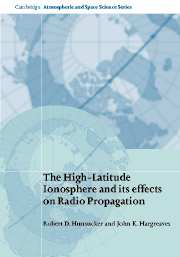Book contents
- Frontmatter
- Contents
- From the Times of London
- Preface
- Chapter 1 Basic principles of the ionosphere
- Chapter 2 Geophysical phenomena influencing the high-latitude ionosphere
- Chapter 3 Fundamentals of terrestrial radio propagation
- Chapter 4 Radio techniques for probing the ionosphere
- Chapter 5 The high-latitude F region and the trough
- Chapter 6 The aurora, the substorm, and the E region
- Chapter 7 The high-latitude D region
- Chapter 8 High-latitude radio propagation: part 1 – fundamentals and early results
- Chapter 9 High-latitude radio propagation: part 2 – modeling, prediction, and mitigation of problem
- Appendix: some books for general reading
- Index
Chapter 6 - The aurora, the substorm, and the E region
Published online by Cambridge University Press: 02 December 2009
- Frontmatter
- Contents
- From the Times of London
- Preface
- Chapter 1 Basic principles of the ionosphere
- Chapter 2 Geophysical phenomena influencing the high-latitude ionosphere
- Chapter 3 Fundamentals of terrestrial radio propagation
- Chapter 4 Radio techniques for probing the ionosphere
- Chapter 5 The high-latitude F region and the trough
- Chapter 6 The aurora, the substorm, and the E region
- Chapter 7 The high-latitude D region
- Chapter 8 High-latitude radio propagation: part 1 – fundamentals and early results
- Chapter 9 High-latitude radio propagation: part 2 – modeling, prediction, and mitigation of problem
- Appendix: some books for general reading
- Index
Summary
Introduction
By “aurora” people usually mean the emission of light from the upper atmosphere, but in fact there are numerous related phenomena, each being a direct or indirect consequence of energetic particles entering the atmosphere from the magnetosphere. They include
(a) luminous aurora;
(b) radar aurora, by which is meant the reflection of radio signals from ionization in the auroral region;
(c) auroral radio absorption, the absorption of radio waves in the auroral ionization;
(d) auroral X-rays, which are generated by the incoming particles and may be detected on high-altitude balloons;
(e) magnetic disturbances, due to enhanced electric currents flowing in the auroral ionization, which may be detected by magnetometers;
(f) electromagnetic emissions in the very-low- and ultra-low-frequency bands, which are generated in the magnetosphere by wave–particle interactions (Section 2.5.6), and which then propagate to the ground where they may be detected with a radio receiver or a sensitive magnetometer.
Arising as they do from a common cause, the auroral phenomena display several common properties.
They all exhibit a general relationship with solar activity, though often there is no specific association with any obvious solar event. From the 1930s the term M region was used to signify a hypothetical and unseen solar region causing aurora and magnetic storms, and this served as a unifying hypothesis for some 40 years. It is now well appreciated, of course, that the unseen agent is the solar wind.
[…]
- Type
- Chapter
- Information
- Publisher: Cambridge University PressPrint publication year: 2002



